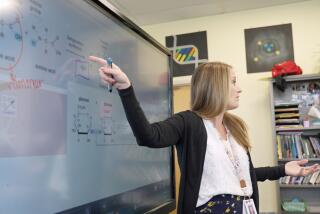Program Aims to Lure Students Into Science With Real-Life Lessons
Connecting abstract knowledge to practical applications in real-life careers may be a key technique for luring more youngsters into jobs in science, engineering and other technical fields, say educators backing a pilot project designed to test the approach.
The program seeks to answer the perennial question of students bored or overwhelmed by seemingly endless streams of facts and theories: “Why do I gotta learn that?”
Students get the answer, the program’s sponsors say, through simple classroom experiments that demonstrate scientific principles used by adults working in technical fields.
To strengthen the connection, the teacher may invite a working professional to help teach the lesson and then talk about his or her work and life in that field.
Confidence Grows
The result, sponsors say, is that more students are inspired to say to themselves: “Hey, I can do that.”
Called COMETS, for Career Oriented Modules to Explore Topics in Science, the program was developed several years ago by Walter S. Smith, a professor of education at the University of Kansas, under a grant from the National Science Foundation.
The program is used in Grades 4 through 9, and, although few schools have installed it in the classroom, the number is expected to grow. For example, teachers from Balboa Gifted and Achieving Center in Northridge and from Monlux Elementary School in North Hollywood attended COMETS training sessions, although the program will not be added to the schools’ curricula until late spring or early summer, school officials said.
“Everybody agrees that in an increasingly high-tech society we need to encourage more students to go into science-related fields,” said Darrell Smedley, a curriculum consultant with the county Office of Education.
Relating Practice, Theory
“This way of relating the practical to the theoretical, and then getting role models to tell how it all fits together into a career, should help achieve that goal,” Smedley said.
The basic materials include a volume that presents a wide range of technical knowledge keyed to career applications, and another volume of profiles of people who have used the knowledge to build successful personal and professional lives.
COMETS caught the attention of TRW Inc., which sponsored workshops throughout the country and then decided to launch a pilot project in Southern California, said Dale Van Natta, the aerospace company’s director of community relations.
He said TRW plans to expand the program to other major metropolitan areas after educators here have gained classroom experience with the basic concepts.
“To get the thing going, we needed to train and motivate a corps of teachers who would take the ideas and materials back to their districts and train other teachers,” Van Natta said. “It’s a networking approach.”
80 Teachers
The networking began in November with workshops at El Camino College and TRW facilities in Redondo Beach. Smedley, the county’s COMETS coordinator, said about 80 teachers from districts throughout the county attended sessions conducted by Smith.
Smedley said that only a few schools have begun using the program in classrooms but that a wider application is expected when teachers have had more time to fit COMETS into existing curricula. Training of more teachers will continue through the school year and next summer, he said.
Much of the COMETS material is pitched at making careers in science attractive to girls and minorities. All profiles of successful professionals, for example, feature minority and white women.
To further promote that goal, COMETS has been paired with another program developed at the University of California, Berkeley. Its purpose is explained in its acronym, SPACES--Solving Problems of Access to Careers in Engineering and Science.
‘Need More Minorities’
“We need to break the old stereotypes that tell young people that only men can be scientists and engineers, or machinists and gardeners,” Smedley said, “and we need more minorities in hi-tech careers.”
James Kerker, a physics and chemistry teacher in the El Segundo Unified School District who is coordinating COMETS there, offered a personal example of how stereotypes can block career aspirations.
“My teen-age daughter said she would like to be an architect but she couldn’t because she’s a girl,” Kerker said. “That really brought home to me the value of a program like COMETS that can help overcome these cultural barriers.”
Another important feature of COMETS, Kerker said, is its focus on reaching students in the early grades before they make up their minds on careers. Kerker would like to see the starting point pushed back even further than Grade 4.
“By the time the kids reach high school,” he said, “it’s usually too late to affect their basic attitudes about what they want to do with their lives.”
Praise From Teacher
Bernadette Cowart, a teacher at Calle Mayor Middle School in Torrance, didn’t waste time in introducing COMETS to her eighth-grade science students.
“The hands-on activity in the classroom really promotes retention of the material,” she said. “When the kids participate actively in the lesson, their interest level goes up and they retain about 90% of the information.”
Cowart said she has used the life science and health section of COMETS and plans to go on to the physical science and math portions.
One lesson under “Light and Sight” invites students to place transparent waxed paper over a newspaper and sprinkle drops of water on it. An optometrist may be invited to the classroom to explain why the drops magnify the letters and how the principles of light refraction are used in his--make that her--profession.
More to Read
Sign up for Essential California
The most important California stories and recommendations in your inbox every morning.
You may occasionally receive promotional content from the Los Angeles Times.









